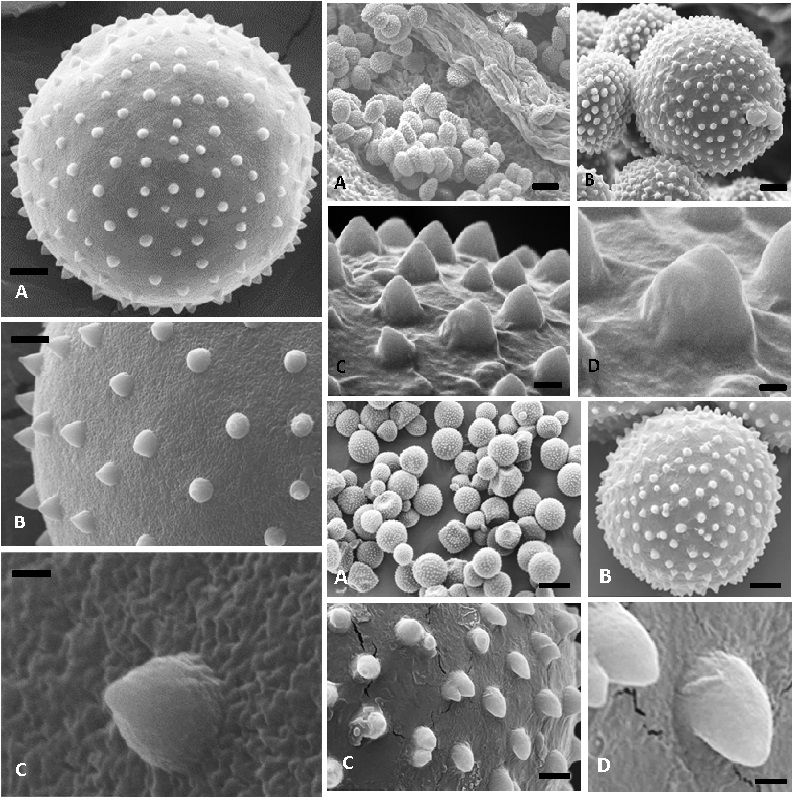Pollen morphology and viability in species of Canna L. (Cannaceae- Zingiberales) and related hybrids.
DOI:
https://doi.org/10.31055/1851.2372.v55.n2.23738Keywords:
Canna, C. x generalis, Cannaceae, domestication, morphology, pollen grains, spines, viabilityAbstract
Background and aims: Cultivars of Canna resulted of intensive hybridization on five parental species: C. flaccida Salsb., C. glauca L., C. indica L., C. iridiflora Ruiz et Pav. and C. warscewiczii A. Dietr. Here we study for the first time the palynological morphology and pollen viability of three hybrids belonging to the nothospecies C. x generalis and three parental species, C.glauca, C. indica and C. warscewiczii, that grow in Argentina. The objective of this work is contributed with information about hybridization and artificial evolution of the genus Canna through a study of palynological morphology and pollen viability.
M&M: Pollen grains of live flowers were observed with an optical microscopy following Wodehouse technique. As Canna pollen grains do not resist Erdtman acetolysis, the observation of sporoderm and spines was performed with a scanning electronic microscope, whereas pollen viability was studied through MTT technique, (Rodriguez- Riano & Dafni 2000).
Results: In wild species the shape and size of pollen grains are regular as well as the size, morphology, distribution, and density of spines. In the hybrids the mentioned traits result irregular and spines density is 2-3 times higher.
Conclusions: Pollen viability results were correlated with the presence and absence of seeds.
References
BAILEY, L. H. 1923. Various cultigens and transfers in nomenclature. Gentes, Herb. 1: 120.
BAILEY, L. H. 1930. Canna x generalis. Hortus, 18. https://doi.org/10.1002/bjs.1800187007
BAILEY, L. H. 1951. Manual of cultivated plants. MacMillan Publishing Co. New York.
BRICKELL, C. D., C. ALEXANDER, J. J. CUBEY, J. C. DAVID, H. A. HOFFMAN, A.C. LESLIE, V. MALECOT, XIAOBAI JIN. (eds) 2009. International Code of Nomenclature for Cultivated Plants.
CICIARELLI, M. M. 2007. Canna ascendens Ciciarelli (Cannaceae) una nueva especie de la provincia de Buenos Aires y comentarios de otras especies argentinas de este género. Darwiniana 45: 188-200
CICIARELLI, M. M. 2014. Canna lineata Ciciarelli, una nueva especie para los humedales bonaerenses, Argentina. Bot. Complutensis 38:115-121.
https://doi.org/10.5209/rev_BOCM.2014.v38.45780
CICIARELLI, M. M. 2015. Canna tandilensis Ciciarelli (Cannaceae-Zingiberales) una especie nueva para Argentina. Bot. Complutensis. 39: 87-96.
https://doi.org/10.5209/rev_BOCM.2015.v39.49137
CICIARELLI, M. M., PASSARELLI, L.M. & ROLLERI, C.H. 2010. Morfología del polen en especies de Canna L. (Cannaceae, Zingiberales) y su implicancia sistemática. Rev. Biol. Trop. 58: 63-59.
https://doi.org/10.15517/rbt.v58i1.5194
CICIARELLI, M. M. & ROLLERI, C.H. 2008. Morfología, taxonomía y caracterización de siete especies neotropicales del género Canna (Cannaceae-Zingiberales). Bot. Complutensis 32: 157-184.
CICIARELLI, M. M., ROLLERI, C. H., M. C. GONZALEZ DUBOX. 2010b. Canna fuchsina (Cannaceae- Zingiberales), una especie nueva para la Argentina y sus relaciones con otras especies del género. Bot. Complutensis 34: 49-55.
ERDTMAN G. 1960. The Acetolysis Method - A Revised Description. Svensk Botanisk Tidskrift 54: 561-564.
KHOSHOO, T. N. & I. MUKHERJEE. 1970. Genetic-evolutionary studies on cultivated cannas. Origin and Evolution of Ornamental Taxa. Theoret. Appl. Genetics. 40: 204-217. https://doi.org/10.1007/BF00285243
KHOSHOO, T. N. & I.MUKHERJEE. 1970b. Genetic-evolutionary studies on cultivated cannas. Pollination mechanism and breeding system. Proc. Indian. Natn. Sci. Acad. 36: 271-274.
KHOSHOO, T.N. & I. MUKHERJEE. 1970c. Genetic-evolutionary studies on cultivated cannas. Parallelism between induced and natural mutations. Rad. Botany 10 (4):351-364. https://doi.org/10.1016/S0033-7560(70)80076-X
KHOSHOO, T. N. & I. MUKHERJEE. 1970d. Genetic-evolutionary studies on cultivated cannas. Intraspecific polyploidy in yielding Canna edulis. Genetica Iberica 67: 137-138.
MAAS-VAN DE KAMER, H. & P. J. M. MAAS. 2008. The Cannaceae of the world. Blumea 53: 247- 318.
MUKHERJEE I. & T. N. KHOSHOO, T. N. 1970a. Genetic evolutionary studies on cultivated cannas. Variation in phenotype. Proc. Indian. Natn. Sci. Acad. 36 B: 254:270.
MUKHERJEE I. & T. N. KHOSHOO, T. N. 1970b. Genetic evolutionary studies on cultivated cannas. Taxonomic treatment horticultural classification. J. Bombay Nat. Hist. Soc. 67: 137-138.
NAIR, P. K. K. 1960. Pollen grains of cultivated plants. I: Canna. J. Indian Bot. Soc. 39: 373-381.
RODRIGUEZ-RIANO, T. & A. DAFNI. 2000. A new procedure to asses pollen viability. Sex Plant Reprod. 12: 241- 244. https://doi.org/10.1007/s004970050008
SEGEREN, W. & MAAS, P. J. M. 1971. The genus Canna in Northern South America. Acta Bot. Neerl. 20: 663- 680. https://doi.org/10.1111/j.1438-8677.1971.tb00210.x
SHIVANNA K. R. JOHRI B. M. 1985. The Angiosperm pollen: Structure and Function. Wiley Eastern Lim. New Delhi, India.
TANAKA, N. 2001. Taxonomic revision of the family Cannaceae in the New World and Asia. Makinoa ser. 2: 31-3.
TOKUGAWA Y & KUWADA Y. 1924. Cytol. stud. on some garden varieties of Canna. Jap. Journ. of Bot. Bd. 2: 152-170.
WODEHOUSE, R. P.1935. Pollen grains. Their structure, identification and significance in science and medicine. Mc. GrawHill. Nueva York.

Downloads
Published
Issue
Section
License
Copyright (c) 2020 Boletín de la Sociedad Argentina de Botánica

This work is licensed under a Creative Commons Attribution-NonCommercial-NoDerivatives 4.0 International License.
Provides immediate and free OPEN ACCESS to its content under the principle of making research freely available to the public, which fosters a greater exchange of global knowledge, allowing authors to maintain their copyright without restrictions.
Material published in Bol. Soc. Argent. Bot. is distributed under a Creative Commons Attribution-NonCommercial-ShareAlike 4.0 International license.




